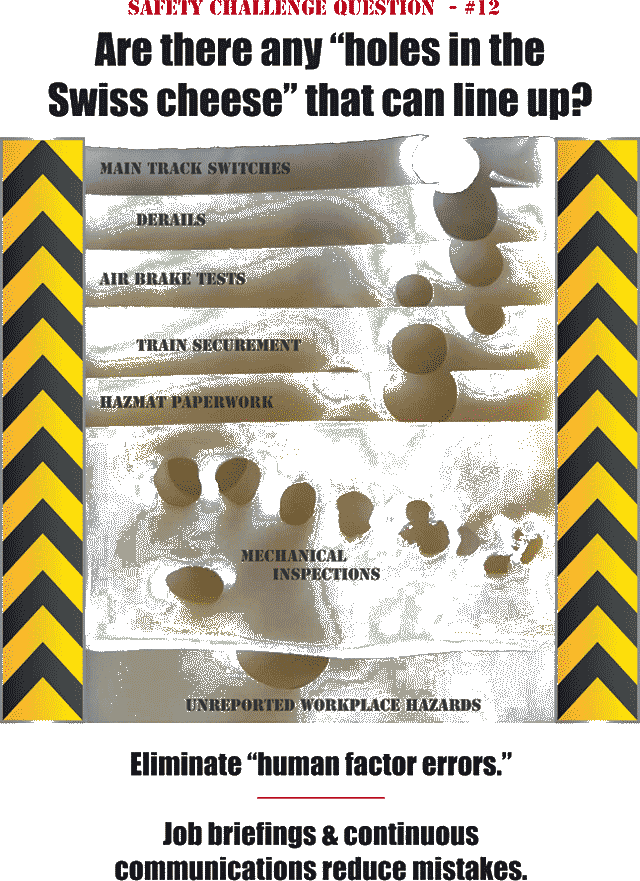
Lake Meganitic - After nearly three months of emotional courtroom proceedings and nine days of jury deliberations, three former employees of Ed Burkhart's now-defunct Montreal Maine & Atlantic Railway (MMA) were found not guilty of all charges arising from the 2013 Lake Megantic oil train disaster.
On 19 Jan 2018 the blindfolded lady holding the scales of justice determined the immediate futures of locomotive engineer Thomas Harding, rail traffic controller Richard Labrie, and Jean Demaitre, MMA's operations manager.
They won't face prison.
OKthePK Joint Bar Editor: As of this date a hearing on the Federal charges against Thomas Harding is yet to take place.
But they now have the daunting task of putting their lives back together after being embroiled in the Canadian legal system for four and a half years.
Dozens of prosecution witnesses provided vivid descriptions of multiple alleged safety-related operational failures of the defendants, their supervisors, railroad equipment, the MMA's safety culture, and Transport Canada (TC), the Canadian equivalent of America's Federal Railroad Administration (FRA).
So, while the hard-fought trial is complete, the lessons MMA's runaway oil train disaster can provide will have a long and useful life, provided those concerned with railroad safety will study the case specifics.
The Transportation Safety Board (TSB) of Canada's 12 page report (downloadable here) covers MMA and the runaway oil train.
It is a good place to start learning about the cataclysmic events of 5 and 6 Jul 2013, MMA's prior management practices creating contributory causes, and the results of TSB investigations.
History's final verdicts on events before and after the tragedy will be a long time in coming.
When written, that volume could be titled "The Night All the Swiss Cheese Holes Lined Up".
However, some initial perspectives are emerging.
Safety Culture and "If Only"
MMA's "generally reactive" approach to safety, rather than a proactive one, was a major construct of the shoddy safety culture identified by TSB, which also found, "There were significant gaps between the company's operating instructions and how the work was done day to day."
On the night of the disaster, it is likely that if only one of the management decisions had been different, or if only one of the equipment conditions had not been present, the trio of railroaders would have never been in a courtroom.
The mechanical condition of lead locomotive number 5017 leads to one the event's many "If Only" situations:
- If only operations manager Dematrie had not dismissed the 4 Jul 2013 report by engineer Francois Daigle that 5017 was belching black exhaust plumes;
- If only 5017 had not caught fire;
- If only 5017 not been rewired in a way that violated TC safety regulations;
- If only an MMA employee with air brake system knowledge had been sent to check on the train after 5017's fire had been extinguished.
Any change in these actions might have prevented just one Swiss Cheese hole from lining up, and the catastrophe may not have occurred.
The testimony of MMA's former safety and training supervisor provided an unflattering portrait of MMA management.
Michael Horan was on the witness stand for six days.
During one particularly rigorous cross-examination, Horan told the court he had no formal training in safety education, had no budget, and needed prior authorization to use his company credit card.
Horan should have been the tip of the spear when it came to implementing MMA's Safety Management System (SMS), the U.S. equivalent of which is 49 CFR Part 217.9, FRA Program of Operational Tests and Inspections.
Horan had a title, but that was about all.
If only...
The TSB report notes MMA had implemented its SMS in 2002.
However, TSB stated TC never audited MMA's SMS until 2010, and that other prior inspections showed "clear indications" the SMS was not working properly.
One of those clear indications was the discovery by Canadian investigators of another improperly secured MMA oil train on 8 Jul 2013 while Lac-Megantic's downtown was still smoldering.
If only...
The Crown's Weak Case
The prosecution's case was so weak that defense attorneys elected to rely solely on cross-examining prosecution witnesses for exoneration.
Witnesses necessary to establish prosecution facts were far from ideal and actually had created some of those Swiss Cheese holes that lined up on the fateful night.
One of the best assessments of the Crown's weak case came from Railroad Workers United (RWU).
In its celebratory news release after the not guilty verdict, RWU stated, "While the prosecution focused largely on a single event, the alleged failure of the locomotive engineer to tie enough hand brakes, they were tripped up at every turn by their own witnesses, government, company, "expert", and otherwise, who, by their testimony, incriminated the company and the government regulators rather than the defendants."
Safety Culture Impact on Jurors
Did MMA's weak safety culture exposed by skilled defense cross-examinations provide jurors with a mitigating factor?
Did it predestine the defendants' failures and therefore predestine they could not be held criminally accountable?
We'll likely never know, because, unlike in the U.S., Canadian juror identities are kept confidential.
The media can't go knocking on doors, soliciting comments.
Thomas Walsh, engineer Harding's attorney, did provide his perspective on jury deliberations in a 22 Jan 2018 media interview.
Walsh said the jury worked hard and got it right.
Walsh's and Harding's personal backgrounds are interesting.
Walsh is not an established, well-known "railroad lawyer", but has a general criminal defense practice in Sherbrooke.
Harding comes from a railroad family.
His two brothers are engineers and his father was an engineer.
The jury knew that.
Walsh admitted the trial established that Harding did not secure sufficient hand brakes and then did not conduct a correct "roll test" on his train.
If only...
Walsh said he repeatedly sought during the trial to show that MMA, "had a totally dysfunctional safety management system and was not doing anything nearly adequate to keep the railroad safe. You have to keep identifying and correcting safety lapses."
His comments mirror TSB's findings.
"The jury saw Harding was basically a good man. He was thought to be a superior train engineer."
Harding was, according to Walsh, "guilty of imperfect compliance, which is a far cry from criminal negligence."
Canadian Media
Canadian reporters generally got it right in their initial event and trial coverage.
The Lake Megantic trial dealt with many complex technical issues relating to air brake systems, train securement, TC safety regulations, and other industry complexities.
A review shows the reporting helped the average citizen correctly understand the event and the trial.
U.S. railroad managers, many knowing my media background, often quietly, and rightfully, complain about local news reporters' lack of factual rail industry knowledge.
This unfamiliarity regularly appears in U.S. rail-related news reports.
Professional railroaders cringe when the word "trains" is substituted for "cars".
And we've occasionally heard something along the lines of, "the engineer steering the train at the time of the collision pressed on the brake pedal but was unable to stop in time."
Good God!
On scale of 1 to 10, the Canadian media's reports were at least a 9.
Those interested in studying the trial generally can rely on those reports.
OKthePK Joint Bar Editor: Except for the propensity to call the Locomotive Engineer a Conductor and not knowing the difference between a locomotive and a train.
Labor Unions
Several railroad labor unions came to the vigorous defense of Harding, Dematrie, and Labrie.
The jury verdict, unions say, validate concerns about "blame the worker first" policies they allege have been wrongly adopted by railroads and government safety regulators.
Dennis Pierce, National President of the Brotherhood of Locomotive Engineers and Trainmen (BLET) and President of the Teamsters Rail Conference, stated, "Although it remains a travesty that criminal charges were ever filed, justice was served in the unanimous not guilty verdict. As the jurors rightly determined, blaming the workers for the Lake Megantic catastrophe was the wrong thing to do."
RWU also has long campaigned against "blame the workers first" policies.
Its Lake Megantic news release also celebrated the verdict and concluded, "Railroad workers must be ready, willing, and able to come to one another's defense to prevent the rail carriers and the state from criminalizing our behavior while they, the real criminals, get off Scott free."
Note: RWU is not involved in contract negotiations so it tends to use such strongly charged language.
What about the trend toward criminalization of railroad accidents?
This is hard to define.
Criminal negligence laws and individual culpability thresholds vary widely from state to state.
The Amtrak Cascades Train 501 derailment occurred in Pierce County, Washinton, On 16 Jan 2018 (before the Lake Megantic verdict), the Pierce County Prosecuting Attorney's Office's public information office stated, "Nothing has been referred to our office as of yet and there is no indication anything is forthcoming in the near future."
Clearly, that's far from a definitive slam-the-door statement.
And it's a certainty the Quebec jury's verdict is being reviewed there.
The View From 40,000 Feet
After reviewing the trial and its testimony, it's clear that if it could have been indicted, MMA's safety culture should have been at the defense table.
But what exactly is a "safety culture," of which TSB, TC, FRA, and NTSB often speak?
Many of the definitions come from the chemical manufacturing and health care industries.
One of the best transportation definitions came from the NTSB in the mid-1990s.
Found in the agency's report on Amtrak's 23 Mar 1993 Big Bayou Canot crash.
Keep in mind NTSB was evaluating an inland waterway operator and its personnel who, lost in a dense fog, slammed a barge tow into a railroad bridge in front of Amtrak's Sunset Limited.
One of the best unofficial definitions came from a now-retired CSX Florida Business Unit safety manager.
"It's how we do safety around here," said Garry Metcalf in 1994 at a then-new FBU Safety Overlap Program meeting.
"You know a good safety culture when you see it."
At the operational level, establishing a safety culture requires ensuring that situations that might later be described as an "If Only" do not become primary, proximate, contributing, or root causes.
In the field, keeping the Swiss Cheese holes from lining up takes work (man-hours), money, total workforce participation, and a truly supportive corporate commitment.
Strategically, it's always better to avoid creating Swiss Cheese slices in the first place.
That's what a true safety culture does.
Art Miller.
under the provisions in
Section 29 of the Canadian
Copyright Modernization Act.



